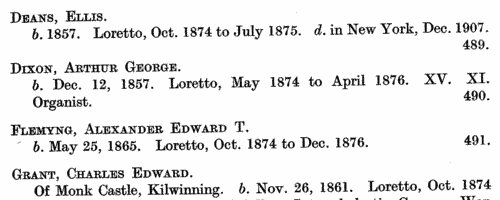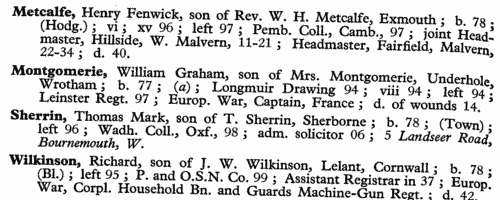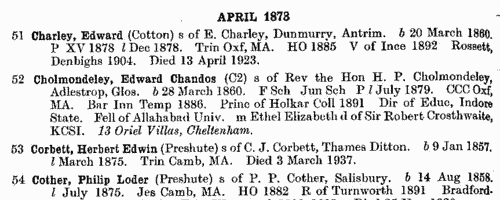Langhorne Surname Ancestry ResultsOur indexes 1000-1999 include entries for the spelling 'langhorne'. In the period you have requested, we have the following 145 records (displaying 121 to 130): Single Surname Subscription | | | Buying all 145 results of this search individually would cost £714.00. But you can have free access to all 145 records for a year, to view, to save and print, for £100. Save £614.00. More... |
These sample scans are from the original record. You will get scans of the full pages or articles where the surname you searched for has been found. Your web browser may prevent the sample windows from opening; in this case please change your browser settings to allow pop-up windows from this site. Boys entering Loretto School
(1882)
The Reverend Dr Thomas Langhorne, who came to Musselburgh in Midlothian as an Episcopalian Church clergyman, established a small school for boarders and day scholars at Loretto House, so called because the grounds contained the ruins of the mediaeval chapel of St Mary of Loretto. To celebrate the centenary of the school in 1925, a second edition of the school register was published, edited by A. H. Buchanan-Dunlop. Relatively little was known of many of the earliest scholars, but from 1835 onwards the register generally gives full name, in capitals, surname first; date of birth; period of time at Loretto; a brief biography; date of death; whether brother of any other boy in the register; and a sequential number. LANGHORNE. Cost: £4.00.  | Sample scan, click to enlarge

| Classics students at Cambridge University
(1884)
Tripos lists or examination results for the year, arranged by class (First, Second and Third), and within each class in order of score in the examination (students getting exactly equal marks are bracketed together). Each student's surname and college is given: this list was printed in 1890, and was annotated with asterisks to show which students had subsequently become fellows of the university; and with footnotes showing those who became headmasters, &c., elsewhere. The course was divided into parts I and II, with separate examinations, and the results into First Class (split into Divisions 1, 2, 3); Second Class (split into Divisions 1, 2, 3); and Third Class (split into Divisions 1, 2, 3), but the examinants listed purely alphabetically within each division. In the lists for Part II, those students gaining firsts are further annotated with the letters b, c, d or e, denoting the section or sections for which they were awarded first class honours. The letter a indicates that the candidate had also attained a first class standard in section A. An asterisk next to any of these letters indicates special distinction. Women students are listed separately, but on the same basis. These lists are particularly useful in identifying for an individual the fellow-students who will have attended lectures with him; and, where from the college, are likely to have been even more closely associated by having been under the same supervisor. (The sample scan is from the start of the Mathematics Tripos list for 1770)LANGHORNE. Cost: £6.00.  | Sample scan, click to enlarge

| Boys entering Merchant Taylors' School in London
(1886)
Merchant Taylors' School was founded by members of the livery company of the merchant taylors of the city of London in 1561 as a grammar school. By the 19th century this was a major English public school. In 1875 the school removed from Suffolk Lane, in the City, to a new building in Charterhouse Square in Finsbury. In 1907 the Reverend William Baker, a former headmaster, published this school register for the period 1871 to 1900, which we have indexed by year of admission. Each entry gives the boy's name in full (surname, christian name(s)); date of birth; names of both parents (middle names as initials); occupation of father; career summary; and (in italics) address as of 1907.LANGHORNE. Cost: £6.00.  | Sample scan, click to enlarge

| London Priests (1886)
'The Census of Morning and Evening Attendance in the Churches and Chapels of London, Sunday, October 24th, 1886' was compiled by The British Weekly, employing several thousand persons, and extended to every denomination and sect, giving the number of attendances in the morning (M.) and in the evening (E.), and the name of the incumbent or priest conducting the service. 1500 churches and chapels were found at worship in the city on that day: 'the enumeration was made by actual counting, official estimate being in no case accepted when unconfirmed'. The census covered Kensington, Fulham, Chelsea, St George Hanover Square, Westminster, Marylebone, Hampstead, St Pancras, Islington, Hackney, St Giles, Strand, Holborn, London City, Shoreditch, Bethnal Green, Whitechapel, St George-in-the-East, Stepney, Mile-end and Poplar in Middlesex; St Saviour Southwark, St Olave Southwark, Lambeth, Wandsworth and Camberwell in Surrey; and Greenwich, Lewisham, and Woolwich in Kent. These 29 registration districts comprised a population of about 4,100,000. About half a million attended morning service on that day; 269,799 Anglicans, 142,425 Congregationalists, and relatively smaller numbers for other denominations.
LANGHORNE. Cost: £8.00.  | Sample scan, click to enlarge

| Debtors
(1887)
County Court Judgments in England and Wales. July to September 1887LANGHORNE. Cost: £6.00.  | Sample scan, click to enlarge

| Boys entering Merchant Taylors' School in London
(1891)
Merchant Taylors' School was founded by members of the livery company of the merchant taylors of the city of London in 1561 as a grammar school. By the 19th century this was a major English public school. In 1875 the school removed from Suffolk Lane, in the City, to a new building in Charterhouse Square in Finsbury. In 1907 the Reverend William Baker, a former headmaster, published this school register for the period 1871 to 1900, which we have indexed by year of admission. Each entry gives the boy's name in full (surname, christian name(s)); date of birth; names of both parents (middle names as initials); occupation of father; career summary; and (in italics) address as of 1907.LANGHORNE. Cost: £6.00.  | Sample scan, click to enlarge

| Boys entering Westminster School
(1883-1893)
This supplement to the Westminster School Register was published in 1894. It lists boys entering the school from October 1883 to October 1884. They are listed alphabetically by surname and full christian names (in bold), with name, address and (often) occupation of father; sometimes mother's name and maiden name; date of birth; date of admission; and date of leaving. There are further brief notes where the boy had already gone on to university, or was known to have embarked on a career.LANGHORNE. Cost: £4.00.  | Sample scan, click to enlarge

| Boys entering Merchant Taylors' School in London
(1893)
Merchant Taylors' School was founded by members of the livery company of the merchant taylors of the city of London in 1561 as a grammar school. By the 19th century this was a major English public school. In 1875 the school removed from Suffolk Lane, in the City, to a new building in Charterhouse Square in Finsbury. In 1907 the Reverend William Baker, a former headmaster, published this school register for the period 1871 to 1900, which we have indexed by year of admission. Each entry gives the boy's name in full (surname, christian name(s)); date of birth; names of both parents (middle names as initials); occupation of father; career summary; and (in italics) address as of 1907.LANGHORNE. Cost: £6.00.  | Sample scan, click to enlarge

| Boys entering Sherborne School
(1893)
The grammar school at Sherborne in Dorset, which doubtless existed from the creation of the diocese of Sherborne in 705, was refounded by king Edward VI in 1550. At the quatercentenary in 1950, a fourth edition of the Sherborne Register was published, listing boys entering the school during those four centuries. In truth, the materials for this register survive but fitfully before 1823; for some years, no names are known; sometimes all that is known is a surname. But from 1823 onwards the lists and the details get steadily more comprehensive. By the 20th century the boys are listed alphabetically by surname under term of entrance. Surname is given in bold, then christian names, name of father (surname and initials) and address; year of birth; house (a, School House; b, Abbey House; c, The Green; d, Harper House (formerly The Retreat); f, Abbeylands; g, Lyon House; h, Westcott House); whether represented the school at cricket (xi), football (xv), shooting (viii), &c.; year of leaving; summary of degrees, career &c.; and (in italics), address as of 1950. Names in the early lists marked with an asterisk are found inscribed on the oak panelling or on the stone walls of the former schoolroom. (F) in the lists indicates a foundationer, receiving free education: after 1827, when this privilege was restricted to boys from Sherborne and neighbourhood, nearly all foundationers were day-boys.LANGHORNE. Cost: £4.00.  | Sample scan, click to enlarge

| Boys entering Marlborough College
(1895)
The public school at Marlborough in Wiltshire was founded in 1843. In 1952 this, 9th, edition of the college register was published, being a revision by L. Warwick James of the 8th edition (of 1936): but for the years before 1936 it does not merely repeat the 8th edition, because Warwick James was able to correct the 19th-century entries with information from newly-discovered letters and books from 1843 to 1853, and the school lists from 1844 onwards. The roll is arranged by year, and within each year by term of entrance, and then alphabetically by surname within each term. Each boy is assigned a number within the year: then his name is given, surname first, and, in brackets, his house. The houses within the college were called B1, B2, B3, C1, C2 and C3, and the Lower School (L Sch); the out college houses were Preshute, Priory, Cotton, Hermitage, Littlefield, Barton Hill, Summerfield and Upcot. Then there is given the boy's father's name (surname and initials) and address (at entrance), the boy's date of birth (b) and month of leaving (l). Where the boy represented the school at Rugby football (XV) or cricket (XI), in the rifle corps (VIII, or RC XI), that is indicated. There is a brief summary of achievements in later life, and, where known, and date of death or (in italics) address as in 1952. LANGHORNE. Cost: £4.00.  | Sample scan, click to enlarge

|
Research your ancestry, family history, genealogy and one-name study by direct access to original records and archives indexed by surname.
|












